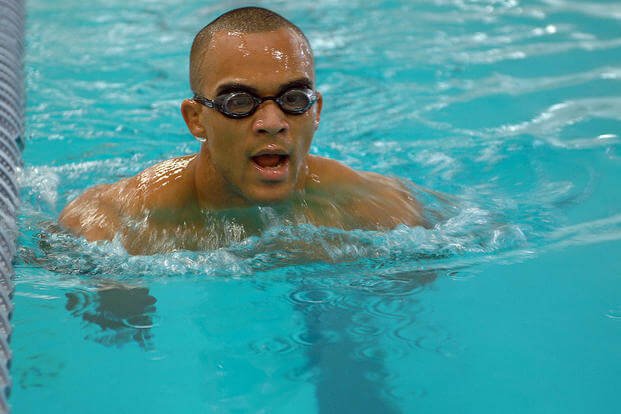There are two propulsion methods for swimming: the arm pulls and the kick. Strategically, you could add the kicks off the wall when testing in a pool as a third, because that is the momentum starter you want to maintain throughout each pool length.
Here is a question from a Navy recruit who is working on his combat swimmer stroke (CSS) to prepare for Navy Dive School:
Stew, I am struggling to get across the pool in as few strokes as possible and keep my time fast. I think my kick is causing it. In the CSS, is the arm pull more important than the kick? It seems like I am getting more out of the arm pull than the kick. Thanks, Derrick.
Derrick, combining a strong kick and streamlined glide is the key to fixing your issue with efficiency and speed in the pool. Check out this perfect CSS swim video. Because this recruit’s streamline is so good, he can exert much less on the kick, enabling him to get a few yards with each kick and glide.
When trying to get across the pool in as few strokes as possible, many will over-glide and lose too much speed and momentum with each stroke. You do not want to do this. There is a sweet spot when it comes to gliding with the CSS, and that is usually 2-3 seconds after the kick and arm recovery into the gliding position. We hold the glide for one Mississippi, two Mississippi and pull on three. Over-gliding loses momentum, and under-gliding wastes momentum; both make you slower.
Strengthening the Scissor Kick (with Fins)
The scissor kick is the most popular choice among the various kicking techniques, especially for land athletes (runners) who may lack fully developed muscles associated with a breaststroke. The CSS is a sidestroke, and a powerful scissor kick works well with it because of the body placement.
However, you can use a breaststroke kick if you have that experience. The choice is yours, but it is crucial to note that the breaststroke kick is not applicable when using fins. In fact, one of the ways I help fix people’s scissor kicks is to add fins. You can use large scuba fins to develop your scissor kick by swimming or treading (with no hands), and it will help you develop a stronger scissor kick when swimming without fins.
Strengthen the Scissor Kick (with Technique)
As you refine your scissor kick, remember that power starts in the hips but transfers to the knees and lower legs as a quick whip kick rather than a wide opening and closing of the hips. In other words, you do not want the scissor kick to be so broad that it slows you down as you start the kick. Instead, focus on swiftly closing your legs from the knees down with a slight opening of the legs at the hips.
A helpful drill to develop this technique is the “half-kick” exercise; this encourages you to maintain a moderate separation of the legs and push hard with a swift kick, closing the legs powerfully. You can do this with a kickboard and make it a workout:
Warm up with a 500-meter swim, then add a kickboard of 25 meters to the 50-50 Workout.
Repeat 10 times.
- Swim 25-meter scissor kicks only with a kickboard (any side)
- Swim 50 meters without the kickboard CSS (focus on the kick and glide)
- Swim 50 meters freestyle
This equals 1,750 meters of swimming in the workout, with 250 meters’ worth of kickboard drills.
The fin and kickboard drills work well to improve your kick with the CSS. If you struggle with your kicking technique, do not hesitate to integrate these specific drills. These targeted exercises can help you develop a more effective kick, improving your speed and efficiency in the water.
Do not forget that a perfect streamline is critical, too. Check out how important it is with this Military.com article.
Want to Learn More About Military Life?
Whether you’re thinking of joining the military, looking for fitness and basic training tips, or keeping up with military life and benefits, Military.com has you covered. Subscribe to Military.com to have military news, updates and resources delivered directly to your inbox.
Story Continues
Read the full article here

